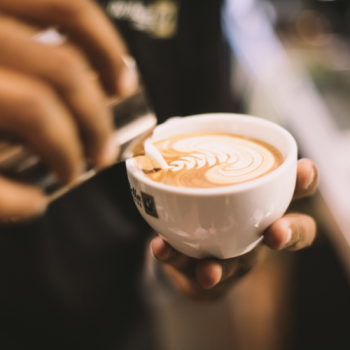Best Coffee For Cappuccino, How to Make one At Home & how popular is it?
- Last Updated:

A cappuccino is a popular coffee beverage that is a staple in cafes around the world.
Characterised by its distinct layers of espresso, steamed milk, and foam, the cappuccino has a rich yet balanced flavour profile. Compared to a latte, we’d describe it as slightly stronger tasting, and ‘coffee forward’. It’s creamy without being too creamy. Although this can vary between barista and shop (especially those larger chains) in the UK, cappuccinos are traditionally served as a 12oz drink alongside americanos and lattes, with flat whites coming in at around 8 – 10oz.
The Anatomy of a Cappuccino
A traditional cappuccino consists of three equal parts:
- one part espresso,
- one part steamed milk, and
- one part milk foam.
How To Steam A Cappuccino
For a cappuccino you use less milk as a starting point than you would when steaming a latte. This is because we are adding more air to create a larger percentage of foam in the finished drink. Generally, this is approximately split into (equal-ish) thirds, as above.
When foaming, the volume of the milk is doubled. Before pouring over the espresso, it’s essential that the milk is kept moving to prevent the foam from setting on top of the steamed milk. Swirl the jug on the counter and gently tap, this will remove any large surface bubbles and start to produce a glossy sheen.
When pouring, do so from a low height and gently wiggle your wrist, this ensures the foam reaches the cup and isn’t left behind in the cup. After a few seconds, the milk starts to settle, with the foam naturally separating, creating a creamy and dense layer on top.
Which coffees would be best for a cappuccino?
Before we take a look at the history and origin of the drink, let’s look at which coffees would taste best as a cappuccino.
Choosing the ‘best’ coffee for a cappuccino involves selecting beans that complement the rich, creamy textured milk while providing a balanced, robust flavour that remains at the forefront of the drink.
Generally, medium to dark roast beans are a good place to start, as they have a fuller body and deep flavour. If you prefer a brighter flavour, look for a blend that contains an African coffee.
Ideal Coffee Varieties for Cappuccinos
1. Espresso Blends: Many coffee roasters create blends that aim to deliver a well-rounded flavour when brewed as espresso. They often combine beans from different regions to achieve a balance of sweetness, acidity, and bitterness. Certain blends intend to showcase different flavour profiles, some of which have a bright acidity, others sweet and chocolatey.
2. Arabica Beans: High-quality Arabica beans are favoured for their smooth, complex flavours. Single-origin Arabica from regions like Brazil, Colombia, and Ethiopia can add unique notes to the cappuccino, such as chocolate, nutty, or fruity undertones.
3. Robusta Beans: Although less common, a small percentage of Robusta beans in an espresso blend can enhance the crema and add a touch of bitterness. These blends are favoured by those who enjoy an Italian or French style coffee. Robusta beans can lack the nuanced flavour of Arabica but deliver that strength of flavour
4. Specialty Coffee: Representing the growers from the top 5% of the supply chain, most Specialty Coffee Roasters work solely with Arabica beans. They possess a naturally sweet and rounded flavour that when roasted a little higher- translates into those rich flavours of chocolate and cocoa that are perfect for espresso-based drinks such as a cappuccino.
Ultimately, the best coffee for a cappuccino is the coffee you like. Medium – dark roasts are a solid option for use in an espresso machine and we may recommend certain origins or blends. But you may favour certain origins or roast profiles more, and that’s totally ok!

